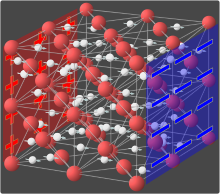Ionic conductivity (solid state)

Ionic conductivity (denoted by
In crystalline solids
[edit]In most solids, ions rigidly occupy fixed positions, strongly embraced by neighboring atoms or ions. In some solids, selected ions are highly mobile allowing ionic conduction. The mobility increases with temperature. Materials exhibiting this property are used in batteries. A well-known ion conductive solid is
History
[edit]Ionic conduction in solids has been a subject of interest since the beginning of the 19th century. Michael Faraday established in 1839 that the laws of electrolysis are also obeyed in ionic solids like lead(II) fluoride (PbF2) and silver sulfide (Ag2S). In 1921, solid silver iodide (AgI) was found to have had extraordinary high ionic conductivity at temperatures above 147 °C, AgI changes into a phase that has an ionic conductivity of ~ 1 –1 cm−1.[clarification needed] This high temperature phase of AgI is an example of a superionic conductor. The disordered structure of this solid allows the Ag+ ions to move easily. The present record holder for ionic conductivity is the related material Ag2[HgI4].[3]
See also
[edit]References
[edit]- ^ Richard Turton. (2000).The Physics of Solids. New York:: Oxford University Press. ISBN 0-19-850352-0.
- ^ a b Lu, Xiaochuan; Xia, Guanguang; Lemmon, John P.; Yang, Zhenguo (2010). "Advanced materials for sodium-beta alumina batteries: Status, challenges and perspectives". Journal of Power Sources. 195 (9): 2431–2442. Bibcode:2010JPS...195.2431L. doi:10.1016/j.jpowsour.2009.11.120.
- ^ Greenwood, Norman N.; Earnshaw, Alan (1997). Chemistry of the Elements (2nd ed.). Butterworth-Heinemann. p. 800. ISBN 978-0-08-037941-8.
External links
[edit]
